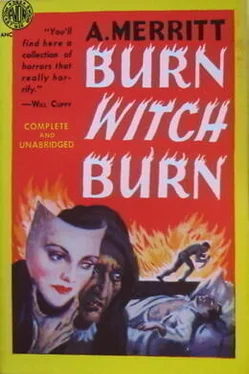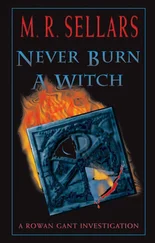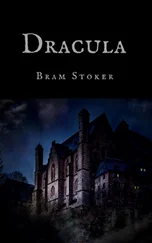Returning to the hospital in his car, I found the body of Peters had been taken to the mortuary. Rigor mortis, Braile told me, had been complete in less than an hour—an astonishingly short time. I made the necessary arrangements for the autopsy, and took Braile home with me to snatch a few hours’ sleep. It is difficult to convey by words the peculiarly unpleasant impression the whole occurrence had made upon me. I can only say that I was as grateful for Braile's company as he seemed to be for mine.
When I awoke, the nightmarish oppression still lingered, though not so strongly. It was about two when we began the autopsy. I lifted the sheet from Peters' body with noticeable hesitation. I stared at his face with amazement. All diabolism had been wiped away. It was serene, unlined—the face of a man who had died peacefully, with no agony either of body or mind. I lifted his hand, it was limp, the whole body flaccid, the rigor gone.
It was then, I think, that I first felt full conviction I was dealing with an entirely new, or at least unknown, agency of death, whether microbic or otherwise. As a rule, rigor does not set in for sixteen to twenty–four hours, depending upon the condition of the patient before death, temperature and a dozen other things. Normally, it does not disappear for forty–eight to seventy–two hours. Usually a rapid setting–in of the stiffening means as rapid a disappearance, and vice versa. Diabetics stiffen quicker than others. A sudden brain injury, like shooting, is even swifter. In this case, the rigor had begun instantaneously with death, and must have completed its cycle in the astonishingly short time of less than five hours—for the attendant told me that he had examined the body about ten o'clock and he had thought that stiffening had not yet set in. As a matter of fact, it had come and gone.
The results of the autopsy can be told in two sentences. There was no ascertainable reason why Peters should not be alive. And he was dead!
Later, when Hoskins made his reports, both of these utterly conflicting statements continued to be true. There was no reason why Peters should be dead. Yet dead he was. If the enigmatic lights we had observed had anything to do with his death, they left no traces. His organs were perfect, all else as it should have been; he was, indeed, an extraordinarily healthy specimen. Nor had Hoskins been able to capture any more of the light–carrying corpuscles after I had left him.
That night I framed a short letter describing briefly the symptoms observed in Peters' case, not dwelling upon the changes in expression but referring cautiously to "unusual grimaces" and a "look of intense fear." Braile and I had this manifold and mailed to every physician in Greater New York. I personally attended to a quiet inquiry to the same effect among the hospitals. The letters asked if the physicians had treated any patients with similar symptoms, and if so to give particulars, names, addresses, occupations and any characteristic interest under seal, of course, of professional confidence. I flattered myself that my reputation was such that none of those who received the questionnaires would think the request actuated either by idle curiosity or slightest unethical motive.
I received in response seven letters and a personal visit from the writer of one of them. Each letter, except one, gave me in various degrees of medical conservatism, the information I had asked. After reading them, there was no question that within six months seven persons of oddly dissimilar characteristics and stations in life had died as had Peters.
Chronologically, the cases were as follows:
May 25: Ruth Bailey, spinster; fifty years old; moderately wealthy; Social Registerite and best of reputation; charitable and devoted to children. June 20: Patrick McIlraine; bricklayer; wife and two children. August 1: Anita Green; child of eleven; parents in moderate circumstances and well educated. August 15: Steve Standish; acrobat; thirty; wife and three children. August 30: John J. Marshall; banker; sixty interested in child welfare. September 10: Phineas Dimott; thirty–five; trapeze performer; wife and small child. October 12: Hortense Darnley; about thirty; no occupation.
Their addresses, except two, were widely scattered throughout the city.
Each of the letters noted the sudden onset of rigor mortis and its rapid passing. Each of them gave the time of death following the initial seizure as approximately five hours. Five of them referred to the changing expressions which had so troubled me; in the guarded way they did it I read the bewilderment of the writers.
"Patient's eyes remained open," recorded the physician in charge of the spinster Bailey. "Staring, but gave no sign of recognition of surroundings and failed to focus upon or present any evidence of seeing objects held before them. Expression one of intense terror, giving away toward death to others peculiarly disquieting to observer. The latter intensified after death ensued. Rigor mortis complete and dissipated within five hours."
The physician in charge of McIlraine, the bricklayer, had nothing to say about the ante–mortem phenomena, but wrote at some length about the expression of his patient's face after death.
"It had," he reported, "nothing in common with the muscular contraction of the so–called 'Hippocratic countenance,' nor was it in any way the staring eyes and contorted mouth familiarly known as the death grin. There was no suggestion of agony, after the death—rather the opposite. I would term the expression one of unusual malice."
The report of the physician who had attended Standish, the acrobat, was perfunctory, but it mentioned that "after patient had apparently died, singularly disagreeable sounds emanated from his throat." I wondered whether these had been the same demonic machinations that had come from Peters, and, if so, I could not wonder at all at my correspondent's reticence concerning them.
I knew the physician who had attended the banker—opinionated, pompous, a perfect doctor of the very rich.
"There can be no mystery as to the cause of death," he wrote. "It was certainly thrombosis, a clot somewhere in the brain. I attach no importance whatever to the facial grimaces, nor to the time element involved in the rigor. You know, my dear Lowell," he added, patronizingly, "it is an axiom in forensic medicine that one can prove anything by rigor mortis."
I would have liked to have replied that when in doubt thrombosis as a diagnosis is equally as useful in covering the ignorance of practitioners, but it would not have punctured his complacency.
The Dimott report was a simple record with no comment whatever upon grimaces or sounds.
But the doctor who had attended little Anita had not been so reticent.
"The child," he wrote, "had been beautiful. She seemed to suffer no pain, but at the onset of the illness I was shocked by the intensity of terror in her fixed gaze. It was like a waking nightmare—for unquestionably she was conscious until death. Morphine in almost lethal dosage produced no change in this symptom, nor did it seem to have any effect upon heart or respiration. Later the terror disappeared, giving way to other emotions which I hesitate to describe in this report, but will do so in person if you so desire. The aspect of the child after death was peculiarly disturbing, but again I would rather speak than write of that."
There was a hastily scrawled postscript; I could see him hesitating, then giving way at last to the necessity of unburdening his mind, dashing off that postscript and rushing the letter away before he could reconsider—
"I have written that the child was conscious until death. What haunts me is the conviction that she was conscious after physical death! Let me talk to you."
I nodded with satisfaction. I had not dared to put that observation down in my questionnaire. And if it has been true of the other cases, as I now believed it must have been, all the doctors except Standish's had shared my conservatism—or timidity. I called little Anita's physician upon the 'phone at once. He was strongly perturbed. In every detail his case had paralleled that of Peters. He kept repeating over and over:
Читать дальше










